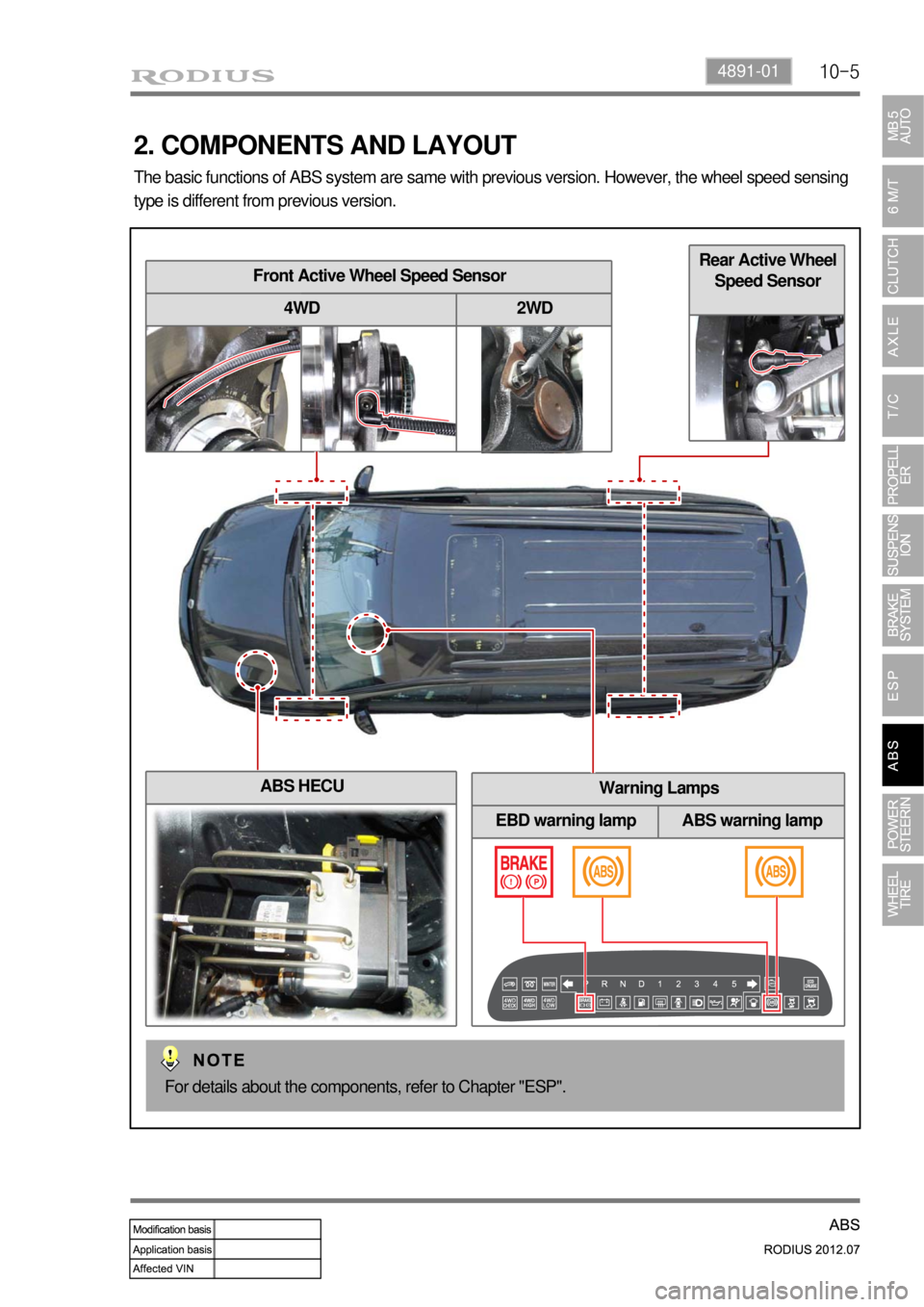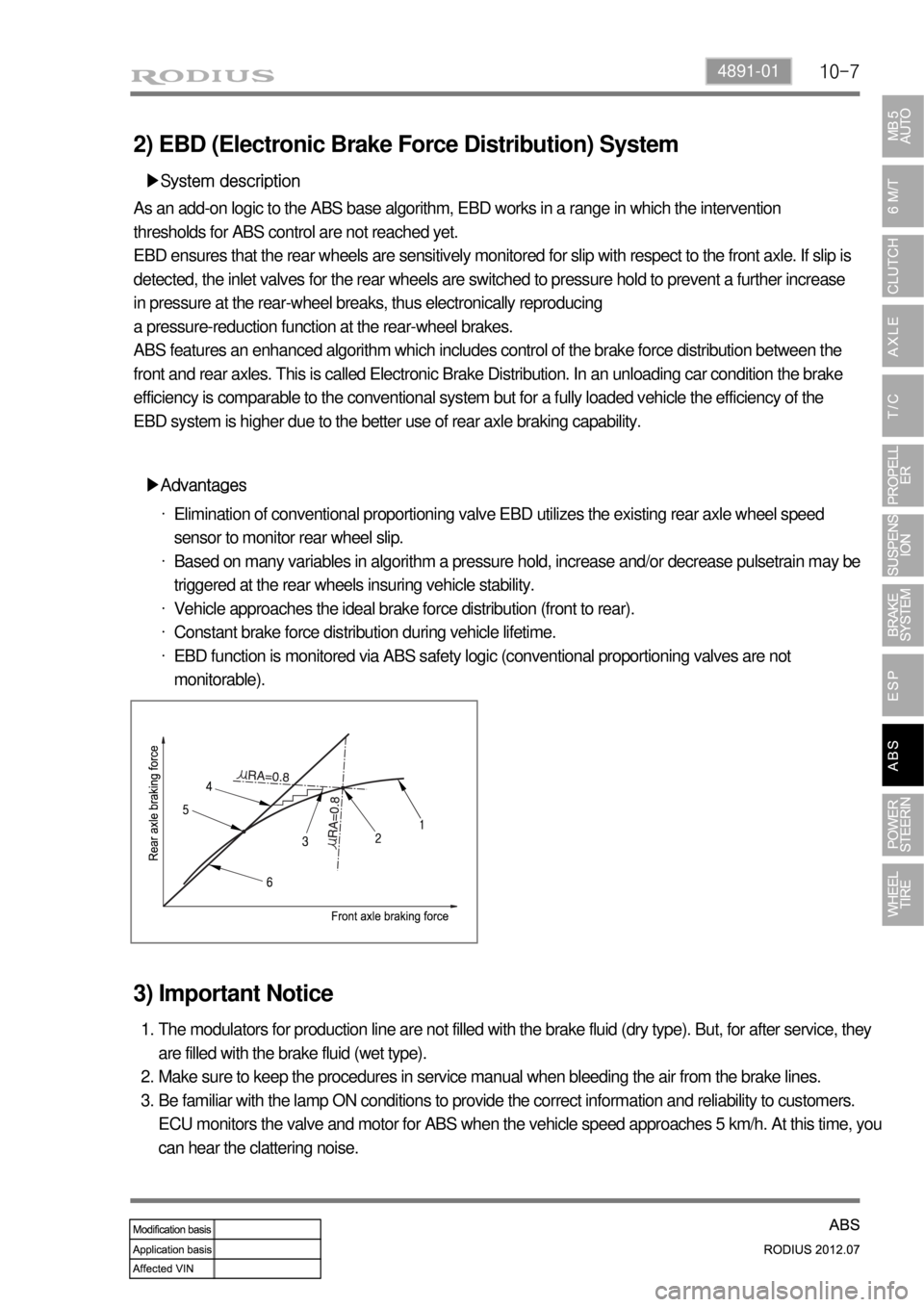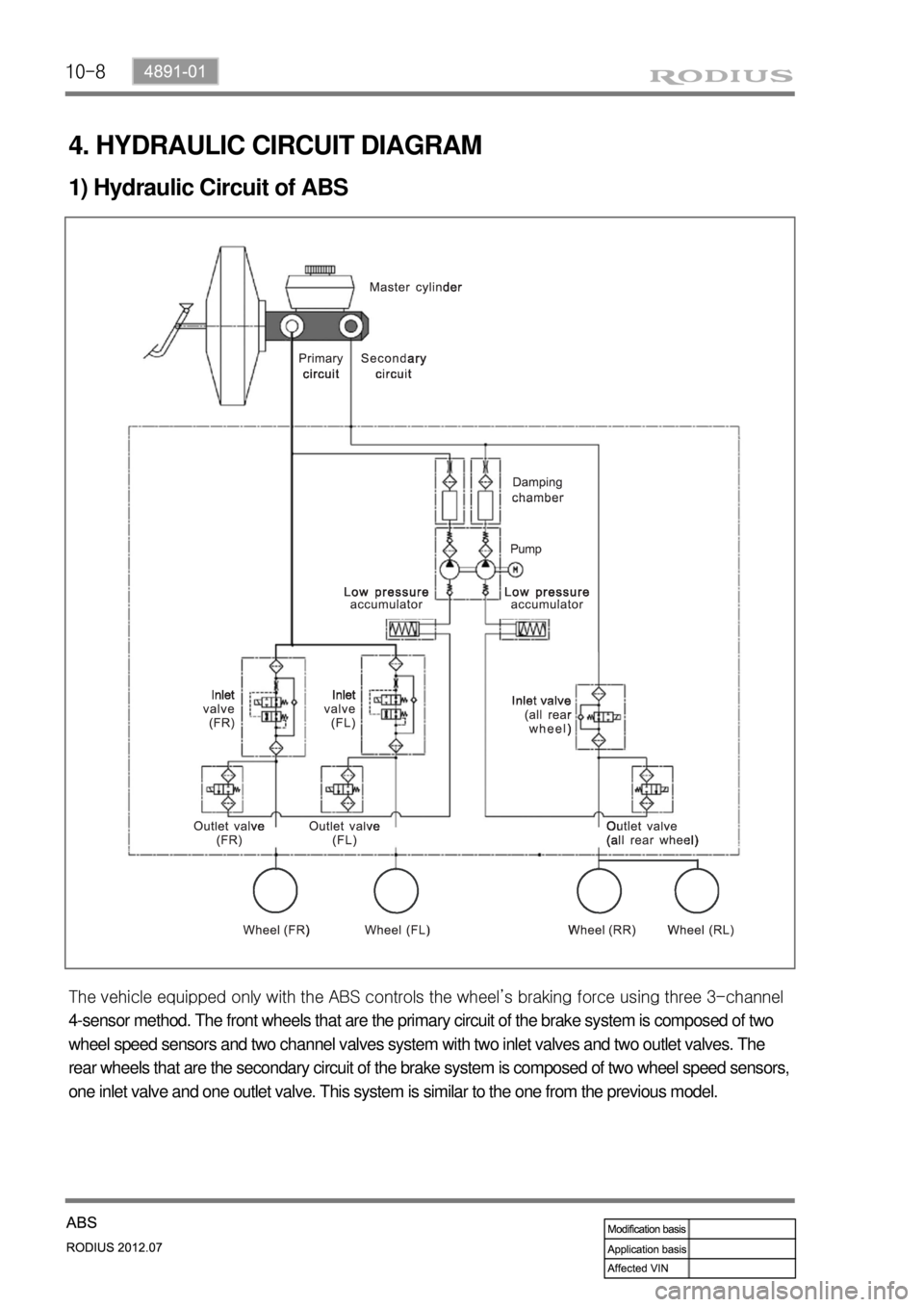sensor SSANGYONG RODIUS 2012 Service Manual
[x] Cancel search | Manufacturer: SSANGYONG, Model Year: 2012, Model line: RODIUS, Model: SSANGYONG RODIUS 2012Pages: 715, PDF Size: 79.36 MB
Page 634 of 715

10-54891-01
Warning Lamps
EBD warning lamp ABS warning lamp
2. COMPONENTS AND LAYOUT
The basic functions of ABS system are same with previous version. However, the wheel speed sensing
type is different from previous version.
For details about the components, refer to Chapter "ESP".
Front Active Wheel Speed Sensor
4WD 2WD
ABS HECU
Rear Active Wheel
Speed Sensor
Page 636 of 715

10-74891-01
2) EBD (Electronic Brake Force Distribution) System
▶System description
As an add-on logic to the ABS base algorithm, EBD works in a range in which the intervention
thresholds for ABS control are not reached yet.
EBD ensures that the rear wheels are sensitively monitored for slip with respect to the front axle. If slip is
detected, the inlet valves for the rear wheels are switched to pressure hold to prevent a further increase
in pressure at the rear-wheel breaks, thus electronically reproducing
a pressure-reduction function at the rear-wheel brakes.
ABS features an enhanced algorithm which includes control of the brake force distribution between the
front and rear axles. This is called Electronic Brake Distribution. In an unloading car condition the brake
efficiency is comparable to the conventional system but for a fully loaded vehicle the efficiency of the
EBD system is higher due to the better use of rear axle braking capability.
▶Advantages
Elimination of conventional proportioning valve EBD utilizes the existing rear axle wheel speed
sensor to monitor rear wheel slip.
Based on many variables in algorithm a pressure hold, increase and/or decrease pulsetrain may be
triggered at the rear wheels insuring vehicle stability.
Vehicle approaches the ideal brake force distribution (front to rear).
Constant brake force distribution during vehicle lifetime.
EBD function is monitored via ABS safety logic (conventional proportioning valves are not
monitorable). ·
·
·
·
·
3) Important Notice
The modulators for production line are not filled with the brake fluid (dry type). But, for after service, they
are filled with the brake fluid (wet type).
Make sure to keep the procedures in service manual when bleeding the air from the brake lines.
Be familiar with the lamp ON conditions to provide the correct information and reliability to customers.
ECU monitors the valve and motor for ABS when the vehicle speed approaches 5 km/h. At this time, you
can hear the clattering noise. 1.
2.
3.
Page 637 of 715

10-8
4. HYDRAULIC CIRCUIT DIAGRAM
1) Hydraulic Circuit of ABS
The vehicle equipped only with the ABS controls the wheel’s braking force using three 3-channel
4-sensor method. The front wheels that are the primary circuit of the brake system is composed of two
wheel speed sensors and two channel valves system with two inlet valves and two outlet valves. The
rear wheels that are the secondary circuit of the brake system is composed of two wheel speed sensors,
one inlet valve and one outlet valve. This system is similar to the one from the previous model.
Page 657 of 715

01-2
Front air conditioner module assembly - inside instrument panel
Compressor - engine rightAQS/Air source selection
switch
Sun load sensor - instrument
panel upper left
1. SYSTEM LAYOUT AND COMPONENTS
Type Air cindotioner controller
FATC
Manual air
conditioner
It change sun load coming through
front windshield into current to input to
FATC controller. *
Air mix door
actuator
PTC (If equipped)
Duct temperature
sensor
Mode door
actuator
Air conditioner wiring
Thermo AMP
Air source door
actuator
Air conditioner
filter
Bloewr motor
Blower high speed relayPower transistor
Page 658 of 715

01-36810-30
Rear air conditioner module assembly - bottom of rear left
Engine ECU - passenger's
footstep
CondenserRecevier driver-condenser
right
Rear fan speed dial
Sub-condenser - right wheel
front
Absorbs moisture in the
refrigerant and reserves
refrigerant to supply
smoothly. *Instslled in front of vehicle and
condenses vapor refrigerant into
low temperature and high
pressure liquid refrigerant *
Condenses high temperature and
high pressure vapor refrigerant into
low-temperature-high-pressure
liquid refrigerant. *
Detects A/C AUTO switch position,
coolant temperature, engine
condition and driving condition to
control the air conditioner *
A sensor that detects coolant
temperature and transmits to
engine ECU *
Blower motor
Power transistor
Air conditoner high
pressure/low
pressure pipe
Air mix door
actuator
Front
Rear
A switch that controls the rear air
conditioner module. *
Collant temperature sensor -
on engine
Page 663 of 715

01-8
2. SYSTEM BLOCK DIAGRAM
A/C compressor OFF conditions ▶
Coolant temperature: over 115℃
Engine speed: over 4,500 rpm for more than 2 seconds
Engine speed: below 650 rpm
Maximum output due to abrupt acceleration
Excessive acceleration
Increased load during engine idling (to prevent the engine from shutting off)
Refrigerant pressure: over 32 bar or below 2 bar
Defects in A/C related system (refrigerant pressure sensor, coolant temperature sensor,
cooling fan) 1.
2.
3.
4.
5.
6.
7.
8.
Page 666 of 715

01-116810-30
Front Blower, Motor (Mode, Circulation), In-car Sensor, Ambient/AQS Sensor ▶
Page 673 of 715

02-58810-03
2. OPERATION
1) Air Bag
▶Air bag inflates when:
<0070009500470099008c009a009700960095009a008c0047009b0096004700880047009a008c009d008c0099008c0047008d009900960095009b0088009300470090009400970088008a009b00530047009b008f008c0047008b00990090009d008c009902
c5009a004700880095008b0047008d009900960095009b0047>passenger’s air bags deploy
at the same time to supplement the seat belts to prevent or reduce any personal injuries. ·
▶Air bag can inflate when:
Underbody impact from the road surface; impact against the curb at a very high speed;
dropping impact onto the road surface with a large angle ·
▶Air bag does not inflate when:
Rollover, side impact or rear impact
If the severity of impact to the vehicle is not significant and the seat belts are enough to
protect occupants. ·
·
Air bag seldom inflates when: ▶
Oblique impact, rollover
Weak impact in which the sensor is unable to detect (under the inflation requirements)
Impact against narrow objects such as a utility pole or a tree
The vehicle falls into a drainage or a puddle
The front of the vehicle crashes into a high impact point yyvehicle such as a truck
Impact on the hood by falling stones
The air bag warning light is on
<00740096008b008c00990088009b008c0047009600990047009a008c009d008c0099008c00470090009400970088008a009b0047009b00960047009b008f008c004700940090008b008b0093008c00470096008d0047009b008f008c0047009d008c008f00
90008a0093008c004700890096008b00a002c5009a0047009a>ide structure. In that case,
only the side curtain air bags deploy. ·
·
·
·
·
·
·
·
Page 675 of 715

02-78810-03
Do not put the seat cover on the front seatbacks. It may interfere with the side air bag inflation.
When sitting in the rear seat, do not hold onto the seatback of the front seat. If the side air bag
inflates, the occupant may get seriously injured.
Do not lean on the door. When the side air bag inflates, the occupant may get seriously injured.
Do not place any objects such as an umbrella or a bag between the side air bag and the door.
Do not place the part of your body near the side air bag. You may obstruct the side air bag or
get injured by the inflation impact.
Do not slam the front doors. It may lead to an unintended inflation of the side air bag.
Do not move your seat too close to the steering wheel or dashboard. If you lower your head,
the air bag can hit your head during inflation and can cause severe injury or even death.
Hold only the outer rim of the steering so that the air bag can inflate without any hindrances.
Do not place your face or chest near the steering wheel and dashboard. Also, do not allow
anyone to place their hands, leg or face on the dashboard. The air bag cannot work properly.
Do not hold and operate the steering wheel by crossing your arms. You could get seriously
injured when the air bag deploys.
When the air bag inflates, it makes a loud noise and smoke. However, the smoke is a non-
toxic nitrogen gas.
When the air bag is deployed, non-toxic gas will come out. This gas may cause skin, eyes or
nose irritation.
Wash it out with cold and clean water and consult the doctor if irritation continues.
When any repairs are needed for the steering wheel, or when an accident occurred without the
air bag deployment, have the air bag system checked by Ssangyong Dealer or Ssangyong
Authorized Service Operation.
The windshield glass may be broken when the passenger's air bag is deployed.
The air bag deployment can cause abrasion on your hands and face. -
-
-
-
-
-
-
-
-
-
-
-
-
-
-
-
4) Major Replacement Parts after Air Bag Deployment
In Case Of Front Air Bag Deployment ▶
Instrument panel, deployed air bag module, air bag unit, seat belt pre-tensioner, wirings
(including connectors), damaged trim and components
In Case Of Curtain Air Bag Deployment ▶
Deployed side bag, air bag unit, side air bag sensor, wirings (including connectors), damaged
trim and seat components